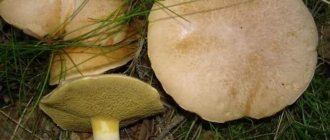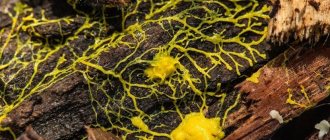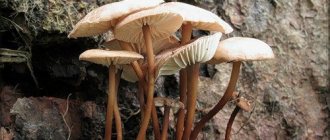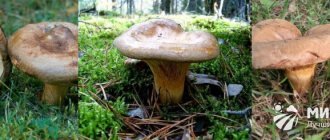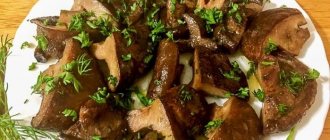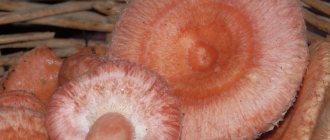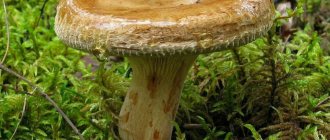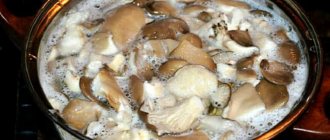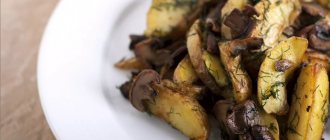Svinushki are mushrooms that cause a lot of controversy. They used to be eaten and considered safe, but today mycologists are calling for mushroom pickers to stop collecting them. This mushroom is dangerous and toxic, capable of accumulating harmful chemical compounds and heavy metals that threaten health, so it should be avoided.
Edible pig mushrooms - types, what they look like, what they can be confused with: description, photo
Pig mushrooms
The fact is that almost all the recipes involving pigs that are now available on the Internet arose during the war, when there was a shortage of food. Accordingly, people ate everything they could get their hands on.
Description:
- Many people believe that pig mushrooms are truly edible. And despite the bitter taste, they can be eaten. The only thing is that before consuming, you need to boil them for about half an hour in water in order to remove the bitterness.
- But some studies have found that pig mushrooms are very dangerous and should not be eaten because they contain protein that can accumulate in the body and destroy red blood cells. And this promotes rapid blood clotting.
- But among the pigs there are also edible varieties, if they belong to the Tapinella genus.
- They look like quite dense, large mushrooms. The leg is underdeveloped. It is thick, short, and has a large funnel-shaped cap. In this case, along the edge the cap can be curved downwards. The color is brown or brownish and is present on the inside of the cap of the plate. This is a fat pig (lat. Tapinella atrotomentosa) - and according to mushroom pickers it is edible.
- In rainy weather, the pulp becomes heavily saturated with moisture and when cut, water oozes out of it.
Until 1981, pig mushrooms were considered conditionally edible mushrooms. Since 1993, all pig mushrooms have been officially considered inedible and poisonous mushrooms.
Also, pigs have a good ability to absorb toxic substances near industrial zones, roads and railways.
Fat pig
Svinushka mushrooms - false: varieties, what they look like, description, photo
Varieties:
- Among the pigs there are also inedible varieties. This is a thin pig, as well as a house mushroom , which now grows in cellars. These types of mushrooms should not be eaten, they are poisonous.
- Thin, poisonous pigs are also called dunki, cow's lip, and pig's lip.
Thin pig
House mushroom
Dunki (pigs, cow's lips)
Alder pigs also belong to the inedible mushrooms. The pulp is dense, white-gray in color. The pulp is yellowish or brown, spongy. On the reverse side the plates are less developed. The leg is also short. Found mainly in September, it is characterized by a slightly bitter taste.
Alder pig
How to distinguish a thin pig from a fat one: comparison, similarities and differences
Thin and thick pigs differ from each other, but the fact is that thick pigs are edible only in the opinion of mushroom pickers.
They differ in the diameter of the cap. In a thick pig, it is up to 20 cm in diameter, while the leg is short, thick, fleshy and 4-5 cm in diameter. But in a thin pig, the leg is thinner and the cap is smaller.
Please note that many mushroom pickers consider thin pig mushroom to be an edible mushroom; if you boil it for half an hour, there is no danger. Then they need to be fried or salted. But not so long ago, studies were carried out according to which the thin mushroom or Dunka, as it is also called, is an inedible mushroom. The fact is that the toxins of this fungus are not excreted, accumulate in the blood, and destroy red blood cells. That is, hemoglobin is gradually removed from them, the kidneys and also the liver are affected.
Anemia, jaundice, and anemia may occur. And the most interesting thing is that during boiling, such mushrooms will not get rid of toxins. According to information provided on Wikipedia, since the end of the 20th century, thick and thin pig mushrooms have been classified as poisonous mushrooms.
Thin Pig Thick Pig
Appearance
The cap grows with a diameter of up to 15 cm, at first it is slightly convex in shape, later it becomes flat, having a small depressed funnel in the center and tightly wrapped velvety-felt edges. The color of the cap changes as the fruiting body ages, from olive-brown to reddish-rusty or ocher-brown. In its youth, it has a small fibrous edge, which disappears as the mushroom matures.
The hymenophore is lamellar, the plates descending along the stalk, wide and sparse, may have internal bridges. The color of the plates is ocher-yellow. Spore powder is brown.
The leg has a length of up to 9, and a thickness of up to 1.5 cm, and can be located in the center or on the side. It is dense and cylindrical, may taper towards the base, and is colored slightly lighter than the cap.
The pulp is soft and loose, yellowish in color, which turns brown when cut. It does not have a pronounced smell or taste.
Edible and inedible pig mushrooms: names, photos
There are few mushrooms similar to pig mushrooms. Svinushka is quite noticeable and easily distinguished from other mushrooms.
According to Wikipedia, the fat mushroom is a conditionally edible mushroom. It is believed that pre-boiling for 30 minutes can remove toxins. Next, you can prepare a variety of dishes from it. In foreign sources, this mushroom is classified as inedible mushrooms due to its low nutritional qualities. The toxic properties of this mushroom have not been fully studied. These mushrooms are considered to have slow-acting poison.
Photos and names of pigs:
Fat pig
Alder pigweed is a mildly poisonous mushroom
Pig talker
Pig eared
Prevalence
The pigs grow in large batches. At the same time, the appearance of the mushroom differs significantly from the classical description and varies depending on its habitat. Most often they are found on the edges, clearings of coniferous or deciduous forests with high soil moisture, less often in meadows or along swamps. Mushrooms grow on stumps or in old fallen trees. And sometimes they settle in the walls of houses made of wood, destroying the structure in the process.
Is it necessary to clean the pigs from the skin and film?
If, despite the fact that mushrooms are conditionally edible (more often called slow-acting poison), you still decide to collect, cook, or pickle them for the winter, we recommend that you soak them in cold water for an hour before processing . During this time, all debris, straws, grass, and soil will come off. It is imperative to remove the sticky film from the surface. Please note that during cleaning, your hands get very dirty and do not wash for a long time. We recommend wearing gloves before cleaning.
pigs
How to process pig mushrooms?
Pig mushrooms are more resistant to worms than other mushrooms (possibly due to toxicity). Therefore, cleaning them is easy. Under no circumstances should you delay cleaning and preparing mushrooms. This is a product that needs to be cleaned immediately, a few hours after collection.
Instructions:
- To do this, you need to cut off the dirt and soak the mushrooms in cold water for 30 minutes.
- Next, use a knife to scrape off the film and remove the stickiness.
- It is necessary to soak the mushrooms again for 2 hours in cold water.
- After this, you need to boil the pork for 30 minutes.
- Under no circumstances should you use the decoction you receive for food.
- Because it contains toxic substances that can cause poisoning
- Pour out this broth, throw the mushrooms in a colander and wait until all the liquid has drained
- Soak the already boiled pigs in cold water for another 30 minutes.
- Only after this can you begin salting or further heat treatment.
Harvest of sinews
Habitats, growing season
The mushroom grows in small colonies, prefers temperate climates and deciduous, coniferous, mixed forest thickets. When going on a “quiet hunt”, it is first of all recommended to study forest edges and clearings, if the region is characterized by marshy areas - along the outskirts of water bodies.
The pigweed bears fruit in the spring-autumn and summer seasons, from the end of June to mid-October. Does not like severe drought and sudden changes in temperature. If a collector finds a clearing with fruiting bodies, it is productive to inspect the nearby inversions; plant spores often develop on them as well.
Are pig mushrooms healthy: benefits and harms
Since the end of the 20th century, Tolsta I, which is mainly common in our area, has been classified as a conditionally poisonous mushroom. After preliminary preparation, a significant part of not only harmful, but also beneficial substances is washed out and goes into the water in which the product is soaked.
Benefit:
- It is worth noting that pigs contain a large amount of lecithin. This is a special protein that does not allow harmful cholesterol to accumulate in the body and prevents stroke and heart attack.
- It contains a lot of fiber, which stimulates intestinal function.
But still, these mushrooms are quite controversial . Many modern scientists believe that they should not be eaten at all, because they contain a toxic substance that can accumulate in the body and, over time, cause serious disruption in its functioning (read about the effects on the body in the article above).
Harm:
- Over time, disruptions in the functioning of the liver and kidneys, as well as the circulatory system, may occur. Please note that the older the mushroom, the more harmful it is. It is in old mushrooms that harmful substances accumulate.
- Due to the presence of muscarine, pig mushroom was classified as a conditionally poisonous mushroom. This poison is also found in fly agarics. The fact is that during boiling, it does not split and does not go into water. Some of it still remains in the mushrooms, so there is a risk of poisoning.
List of poisonous mushrooms
Where does it grow
The mycorrhizal fungus lives among a wide variety of deciduous and coniferous trees. Also exists as saprobe on wood. It is found not only in forests, but also in urban areas. Grows alone, scattered or in a wide community in summer and autumn.
The pig is widespread in the Northern Hemisphere, Europe and Asia, India, China, Japan, Iran, eastern Turkey, in the north of North America up to Alaska. The fungus is more often found in coniferous, deciduous and birch forests, where it prefers damp places or wetlands and avoids calcareous (chalky) soils.
Where does the pig grow?
Pigweed survives in polluted environments where other mushrooms cannot survive. Fruiting bodies are found in lawns and old meadows, on woody material around stumps in autumn and late summer. Several species of flies and beetles use fruiting bodies to lay larvae. The fungus may be infected with Hypomyces chrysospermus, a type of mold. The infection results in a whitish coating that first appears in the pores and then spreads over the surface of the fungus, turning golden yellow to reddish brown in adulthood.
Can there be poisoning from pig mushrooms?
The mushroom is classified as conditionally poisonous and is not recommended for consumption. There are cases of fatal poisoning from pig mushrooms . This mainly happens if you eat not young, but old mushrooms with huge caps. Many scientists note that muscarine, which is contained in fly agarics and pig mushrooms, even if the mushrooms are boiled for 3 hours, remains in the product and can cause serious poisoning. And after three hours of processing, the mushrooms turn into mucus and become inedible.
Therefore, before eating and preparing these mushrooms, think a hundred times . Scientists have proven that pig mushrooms also accumulate heavy metals, which can subsequently cause serious toxic poisoning and disruption of the functioning of many internal organs.
Insidious mushrooms
Your health is in your hands. Don't take risks, because you can find a huge number of edible mushrooms on the shelves. Instead of pig mushrooms, you can collect healthier mushrooms, such as chanterelles and boletus mushrooms.
